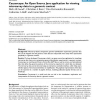203 search results - page 32 / 41 » bmcbi 2004 |
114
click to vote
BMCBI
2004
14 years 11 months ago
2004
Background: Microarray studies in cancer compare expression levels between two or more sample groups on thousands of genes. Data analysis follows a population-level approach (e.g....
129
click to vote
BMCBI
2004
14 years 11 months ago
2004
Background: To identify differentially expressed genes, it is standard practice to test a twosample hypothesis for each gene with a proper adjustment for multiple testing. Such te...
125
click to vote
BMCBI
2004
14 years 11 months ago
2004
Background: A major goal of cancer research is to identify discrete biomarkers that specifically characterize a given malignancy. These markers are useful in diagnosis, may identi...
BMCBI
2004
14 years 11 months ago
2004
Background: With ever increasing numbers of closely related virus genomes being sequenced, it has become desirable to be able to compare two genomes at a level more detailed than ...
106
click to vote
BMCBI
2004
14 years 11 months ago
2004
Background: Microarray-based comparative genome hybridization experiments generate data that can be mapped onto the genome. These data are interpreted more easily when represented...

